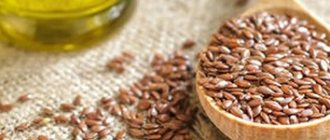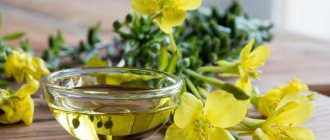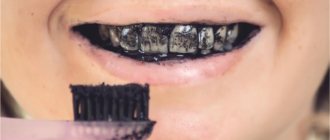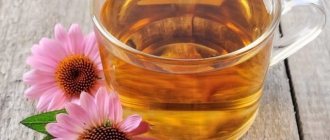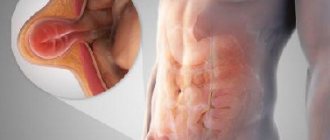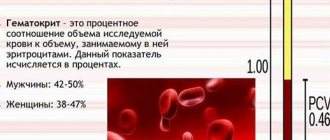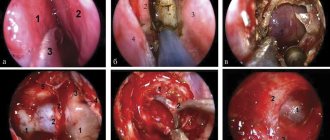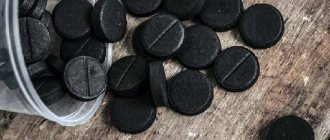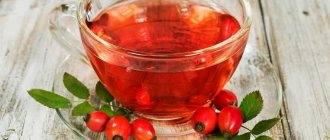Author
Anna Shelestun
Checked by an expert
Tatyana Eliseeva
Our ancestors used echinacea to treat scarlet fever, malaria, diphtheria, and toothache. The plant's popularity began to fade in the 20th century after the advent of antibiotics, but has now faded again thanks to the trend towards organic food. Today people use it to strengthen the immune system, reduce sore throat, and against runny nose and cough. However, scientists have proven that the extract helps not only against colds and flu.
The calorie content of Echinacea is almost zero, but sweetened syrups can contain more than 200 kcal per 100 g. The plant comes in three types - narrow-leaved, pale and purple. All varieties have a common name, but different activity profiles. Their therapeutic effect is provided by polysaccharides, glycoproteins, alkamides, flavonoids and other substances. The roots contain more oils, and the aerial parts contain useful compounds for activating the immune system.
What is Echinacea?
Echinacea is a natural drug that belongs to the group of plants from the Asteraceae family.
It has anti-inflammatory, antiviral, and immunostimulating effects. Stimulates cerebral hematopoiesis, resulting in an increase in the number of leukocytes and cells of the reticuloendothelial system of the spleen. Increases nonspecific resistance of the body. They say that all diseases are caused by nerves. There is a relationship between emotions and the immune system. Today it has been proven that the mechanisms occurring in the nervous tissue are triggered by the immune system, and not vice versa. For example, chronic infections cause chronic depression. Then a vicious circle arises - immune disorders are triggered by stress and depress mood, stress suppresses the immune system. And here the natural herbal preparation Echinacea comes to our aid.
Collection and storage
For medicinal purposes, flowers are collected only in the second year of life. The buds are collected from the moment they bloom, that is, in July-August. The picked flowers are placed in a thin layer on paper and air dried in the attic or under a canopy. The leaves are collected in the fall, as at this time more bioactive substances accumulate here.
The Echinacea rhizome is dug up after the stem dies. Wash, cut into small pieces and spread on paper in a thin layer. It is allowed to dry the roots in the oven at a temperature no higher than +40–50 C to prevent the evaporation of the essential oil. Store in hermetically sealed glass containers.
The shelf life of the herb is 6 months, the root is 3 months.
Echinacea purpurea is grown in gardens as a medicine and for garden decoration. The plant is called a natural antibiotic, because it has such pronounced medicinal properties. At the same time, Echinacea is very beautiful and blooms luxuriantly.
special instructions
- Patients with diabetes should take into account that one tablet of the drug contains about 0.29 g of carbohydrates.
- Since the tincture contains ethanol, it is not recommended to take it while driving or when working with dangerous mechanisms. In this case, you need to give preference to tablets.
- The use of tablets during pregnancy and breastfeeding is possible if it does not harm the baby, and only after consulting a doctor. The tincture is not recommended due to its ethanol content.
- Echinacea is not used for children under 12 years of age.
Compound
In folk medicine, rhizomes and flower baskets of Echinacea are used. The first ones are collected in late autumn, when the plant loses its leaves, the second ones - during flowering. These parts of echinacea contain many active biological compounds useful for humans:
- polysaccharides - arabinoramnogalactans and heteroxylans, biological enzymes, flavonoids, hydroxycinnamic acids;
- echinocin and echonolone are active antioxidants;
- essential oil – up to 0.5% in flowers, and up to 0.23% in roots;
- tannins;
- macro- and microelements – calcium, cobalt, molybdenum, zinc, selenium.
The roots of the plant contain more glycosides, resins, and phytosterols. The share of inulin, a natural prebiotic, reaches 6%, glucose – 7%. A remarkable fact: betaine is isolated from the rhizome - up to 0.1%. This substance prevents strokes and heart attacks.
Popular questions about Echinacea
How to take Echinacea tincture?
It is recommended to take the tincture 3-4 times a day, 20-40 drops to increase immunity, the course of treatment is no more than 8 weeks. The place can be used as a tincture to heal wounds.
How to drink Echinacea tincture to boost immunity?
To boost immunity, take Echinacea 20-40 drops 3-4 times a day, for no more than 8 weeks.
What is better: Immunal or Echinacea tincture?
The drug Immunal contains Echinacea purpurea, which is an analogue of Echinacea. According to patient reviews, the drug is good, but the price is much higher than regular Echinacea.
What are the benefits of Echinacea?
Echinacea is a herbal preparation that can strengthen the immune system and help the body fight pathogens.
Let's start planting seedlings
Echinacea purpurea is grown in the southern and middle regions of Russia. The plant is unpretentious, but very light-loving. For planting, choose hills with fertile, slightly alkaline soil, well-lit. In lowlands, in damp areas, the flower will not grow.
Important! Acidic soil is alkalized by adding lime.
The plant is propagated by dividing the bush or by seeds. The latter method is used to propagate only species specimens, so this method is unpopular.
Dividing the bush can only be done if the plant is already 4 years old. The rhizome is divided into several parts so that each includes 3–4 renewal buds. It is better to carry out the procedure right before landing. You can use ready-made echinacea seedlings from the nursery.
In the selected area, dig holes up to 5–8 cm deep at a distance of 30 cm. Compost is placed at the bottom of the hole and sprinkled with a thin layer of soil.
If the seedling is from a container, it is placed in a hole with its own lump of earth. If they plant after dividing the root, make the hole more spacious and make sure that the root is placed freely in the hole.
The hole is covered with soil and watered abundantly.
Echinacea purpurea is planted in April before sap flow or in October after the leaves have fallen from the trees. Overwintered flowers will appear in the spring.
Note!
The description of the drug Echinacea on this page is a simplified author’s version of the apteka911 website, created on the basis of the instructions for use.
Before purchasing or using the drug, you should consult your doctor and read the manufacturer's original instructions (attached to each package of the drug). Information about the drug is provided for informational purposes only and should not be used as a guide to self-medication. Only a doctor can decide to prescribe the drug, as well as determine the dose and methods of its use.
How to arrange care
No matter how unpretentious a decorative flower may be, it should be looked after, if only in order to maintain the attractive appearance of the flower bed. Recommendations for growing Echinacea purpurea are very simple.
- The plant is watered moderately but often. You need to make sure that the soil is not too wet.
- The perennial needs feeding. In spring and summer, after the flower has completely faded, a mixture of ash and rotted compost is introduced into the ground. The first feeding of Echinacea is done at the 2nd year of life.
- The flowerbed needs to be weeded. Remove faded flowers and stems down to the green leaves. Then the plant blooms more luxuriantly.
- For winter, the above-ground part of Echinacea is cut to the ground. The root zone is covered with dry leaves to protect it from frost.
Important! Nitrogenous fertilizers are introduced into the soil very carefully. They are needed only in spring and only on poor soil.
Interesting varieties
There are many varieties of Echinacea, and new ones are created every year. All varieties can also be divided into 2 types:
- with double flowers, where the center of the basket slowly fades as the flower develops;
- with single flowers with a clearly defined center.
Double coneflowers are more stunning; the single-petalled varieties are much more attractive to pollinating insects. At the height of summer they almost get stuck in them.
We present the most interesting varieties:
- Echinacea "Magnus" Magnus - known for its large pink flowers with a prominent large brown-copper "eye". A tall variety, can reach 100 cm. Despite its relatively large size, it retains the compact vertical shape of the bush and does not fall under the weight of flowers.
- "Butterfly Kisses" Butterfly Kisses - has well-branched, compact bushes, small in size (height 50 cm), which makes it an excellent plant for planting in containers. The flowering is very abundant, lush pale pink flowers evenly cover the bush.
- “Green Jewel” Green Jewel - the variety is known for its unusual color; the flower petals and flowers are green throughout the growing season. This is one of the most unique varieties. Flowers exude fragrance! It will look good in small gardens, as the bush grows up to 60 cm in height and 40 cm in diameter.
- "Delicious Candy" Deliocious Candy - incredible pink color, blooms very profusely, the inflorescences remain fresh for a long time, which makes them a decoration of the garden until autumn! It will beautifully enliven any garden; thanks to its compact size, this variety of echinacea is perfect for growing in the country house, balcony, or terrace.
- "Shayan Spirit" Cheyenne Spirit - multi-colored flowers on one bush! Looking at this variety, it is difficult to believe such a mixture. Flowers - cream, yellow, red and pink! An excellent solution for gardeners who have little space in the garden or on the terrace and who want to enjoy flowers of different colors.
- “White Double Delight” White Double Delight – high grade (height 70-80 cm). Produces numerous cream flowers. It grows very quickly, forming a compact, neat bush.
Photo gallery - other attractive varieties
| Rasberry Truffle | Hot summer |
| Sombrero Flamenco Orange | Mozzarella |
| Virgin | Dixie Bella |
| Hot Papaya | Alba |
| Marmolade | Glowing Dream |
| Cleopatra | Rainbow Marcella |
| Pacific Summer | Leilani |
Echinacea - Native American antibiotic
N. Ruchkina “Chemistry and Life” No. 3, 2020
Echinacea is a North American plant, so the inhabitants of the Old World became acquainted with it quite late. The Englishman John Clayton (1686–1773) can be considered the first describer of Echinacea. In his youth, he went to North America, which was then a British colony, and devoted a significant part of his life to the study of Virginia plants. Clayton corresponded with many famous botanists and sent a description of his collection to one of them, the Dutchman Jan Frederick Gronovius (1686–1762). Gronovius, being an ardent follower of Carl Linnaeus, revised the resulting catalog in accordance with the Linnaean classification and in 1739 published it without the consent of Clayton under the title “Flora of Virginia.” In 1762, the second edition of “Flora” was published (it was published by Laurence Theodor Gronovius, son of Jan Frederick), which for the first time talked about the medical, or more precisely, veterinary, use of echinacea. It was used to treat horse backs knocked down by a saddle. In 1787, this message was duplicated by the German naturalist Johann Schöpf (1752–1800) in the book Materia Medica Americana
, and from then on Echinacea began its path to glory.
Echinacea is a genus of plants in the Asteraceae family, also known as Asteraceae. There are nine known species of Echinacea, all very beautiful, similar to large daisies with pink, yellow or white basket-shaped inflorescences. The central part of the inflorescences is like a dome, and after flowering it becomes almost spherical, and even covered with long bristles. Hence the generic name, derived from the Greek word ekhinos
- 'resembling a hedgehog'.
Three species are used for medicinal purposes: Echinacea purpurea
, pale
E. pallida
and narrow-leaved
E. angustifolia
. Fresh and dried rhizomes, roots and aerial parts of plants are used as medicinal raw materials. Nowadays they are used to make tinctures, extracts, tablets and capsules. White settlers learned to treat themselves with echinacea from the Indians. The Cheyenne, Choctaw, Dakota, Delaware, Kiowa, Omaha, Pawnee, Ponca, Winnebago used it as an anesthetic, to treat poorly healing superficial wounds, boils and abscesses, mild forms of sepsis, as an antidote to snake bites, for sore throat, cough and other symptoms of upper respiratory tract infections, with syphilis.
When Echinacea began to be grown in the Old World, it was noticed by the ancient medical schools of Asia. Echinacea angustifolia fits into the Ayurvedic system as an immunomodulator in the treatment of respiratory diseases, and Chinese doctors called Echinacea purpurea “Song Guo Ju” and is used for the prevention and treatment of respiratory infections.
European doctors really paid attention to echinacea only at the end of the 19th century. They began to actively research it and conducted many in vitro
and on animals.
It turned out that alcoholic and fermented extracts of Echinacea inhibit the growth of Staphylococcus aureus, Pseudomonas aeruginosa, Escherichia coli, acne pathogens, respiratory and skin infections, and even some viruses that cause respiratory diseases. Unfortunately, not all effects discovered in vitro
are confirmed in the clinic.
But there are few clinical trials conducted according to all the rules. In some of them, Echinacea has shown itself to be a good preventive and medicinal product. Subjects are less likely to suffer from upper respiratory tract infections, recover faster, and the risk of complications is reduced by approximately half. However, there were studies in which volunteers who took echinacea for two weeks and then allowed themselves to be infected with rhinovirus (the causative agent of ARVI) were no more resistant to it than participants in the control group. Unfortunately, interpreting these results is difficult because different researchers use different methods, protocols, and categories of subjects. Clinical trials have also not yet confirmed the wound-healing properties of Echinacea. So research continues.
Meanwhile, official medicine has recognized echinacea as an effective means of preventing and combating upper respiratory tract infections, including viral ones (influenza, ARVI), and pharmacists place preparations containing echinacea in the section of general tonics, adaptogens and immunomodulators. Echinacea acts directly against viruses and bacteria, and also “sets” the immune system on them. It is the ability of echinacea to boost the immune system that interests doctors most of all.
Echinacea preparations, in pure form or in combination with other agents, stimulate the phagocytic activity of macrophages, regulate the synthesis of certain cytokines and enhance the immune response. Thanks to these properties, Echinacea, according to experts, can really resist bacterial infections, that is, partly replace antibiotics. Even homeopathic doses of echinacea have an effect on the immune system. And don't think that this is a placebo effect. Homeopathic preparations of echinacea heal cows from mastitis three times faster than antibiotics, and cows cannot have any self-hypnosis. However, the effect of echinacea depends on what drugs it is combined with.
Echinacea contains many biologically active substances: organic acids, vitamins, essential oils, saponins, terpenes, phenolic compounds and alkaloids. Pharmacologists pay special attention to four classes of substances: caffeic acid derivatives, including the glycosides echinacoside, berbascoside and cafeoyl echinacoside, polysaccharides (methylglucuronoarabinoxylan and rhamnoarabinoglucan), glycoproteins and alkamides. Alcohol extracts contain only caffeic acid derivatives and alkamides.
Alkamides are isobutyl amides of unsaturated fatty acids that differ in carbon chain length (11–16 carbons), degree of saturation, and position of saturated carbon bonds. They have anesthetic, cytotoxic, anti-inflammatory, insecticidal and fungicidal properties. It is because of alkamides that Echinacea preparations have a burning aftertaste. Echinacea contains more than 20 alkamides, mainly in the roots.
Echinacea's ability to heal wounds is associated with polysaccharides. Polysaccharides form complexes with hyaluronic acid, and these complexes stimulate fibroblast growth and collagen synthesis. Polysaccharides are sometimes credited with immunostimulating effects, but they are usually broken down in the digestive tract and should not be active if simply ingested.
So far, scientists have not been able to identify the main active ingredients of echinacea. They seem to be working together.
Among the undoubted advantages of echinacea is safety. Indeed, generally healthy people who treat respiratory infections with echinacea tolerate the drug well. However, clinicians do not yet have data on those taking echinacea for more than 8–12 weeks, as trials do not last longer, so overuse should be avoided. You should also consider the interaction of echinacea with other drugs. For example, it retains caffeine in the body, prolonging its effect. Naturally, Echinacea should not be taken simultaneously with immunosuppressants.
Plants of the Asteraceae family cause allergic reactions, mainly skin reactions. There are reports that a person who took echinacea for the first time triggered an asthma attack. Naturally, echinacea is contraindicated for people who suffer from hypersensitivity to plants. Because it affects the activity of the immune system, it is not recommended for people with systemic progressive diseases such as leukemia, tuberculosis, collagen breakdown, multiple sclerosis and other autoimmune diseases. This ban is based on theoretical reasoning, so it has opponents who are convinced that echinacea is not dangerous for autoimmune diseases.
Over the decades, a long list of adverse reactions caused by Echinacea preparations has accumulated. There is a sore throat, high blood pressure, blurred vision, and panic attacks. But these are all isolated cases. Most often, patients complained of headaches (six cases over 40 years) and seizures (five cases).
In general, Echinacea is safe enough to use to protect yourself from infection when everyone around you is sneezing and coughing, or to treat yourself if you do catch a cold.
Artist P. Perevezentsev
